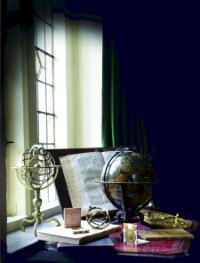Johann Schöner was a mathematician, astronomer, cosmographer, printer and globe-maker of great esteem and influence in the early 16th century. Born in Karlstadt near Würzburg, he was a priest in Bamberg, where he had a printing press and produced maps and globes, and from 1526 he taught mathematics in Nuremberg, where he became a Protestant.
In Nuremberg Schöner befriended, as a guest in his home, a young mathematics professor from the Lutheran stronghold of Wittenberg, Georg Joachim Rheticus. It was Schöner who persuaded Rheticus to make his famous journey north to Frauenberg, where Nicolaus Copernicus was a canon of the cathedral and was known to have a novel astronomical theory.
It was Schöner who first produced a pair of globes of the same size, one of the earth, the other of the heavens. Pairing a terrestrial and a celestial globe in this way became a standard practice for several centuries. In the 16th century this reflected the discipline of ‘cosmography’, which dealt with the relationship between the heavens and the earth.
Featured Objects
5. Celestial globe by Johann Schöner, c.1534
6. Johann Schöner, Globi stelliferi, sive sphaerae stellarum fixarum usus et explicationes (Nuremberg, 1533)
7. Johann Schöner, Tabulae astronomicae (Nuremberg, 1536)
8. Johann Schöner, Opera mathematica (Nuremberg, 1561)
25. Horary quadrant and altitude sundial by Christian Heiden, German, 1553
Previous Panel: Johann Stöffler and the Astrolabe
Next Panel: Rheticus, Copernicus and Reinhold

